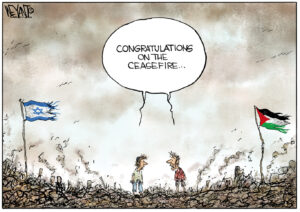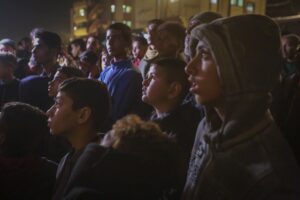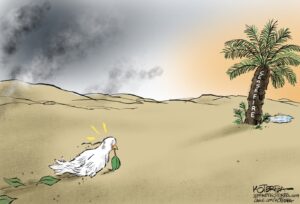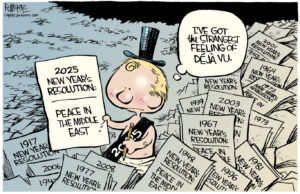Israel’s War on Protesting Children and Other Civilians
Israeli forces deployed along the volatile border with the Gaza Strip are firing live rounds at rock-throwing Palestinian protesters. Raed Abu Khader, right, holds a wet cloth on the forehead of his 12-year-old son, who was shot in the leg at a demonstration. (Felipe Dana / AP)
Raed Abu Khader, right, holds a wet cloth on the forehead of his 12-year-old son, who was shot in the leg at a demonstration. (Felipe Dana / AP)
And for eight months, Israeli snipers have targeted one part of the body more than any other — the legs.
The Israeli army says it is responding to weekly assaults on its frontier by Palestinians armed with stones, grenades and firebombs. The military says it opens fire only as a last resort, and considers firing at the lower limbs an act of restraint.
Still, 175 Palestinians have been shot to death, according to an Associated Press count. And the number of wounded has reached colossal proportions.
Of the 10,511 protesters treated at hospitals and field clinics in Gaza so far, at least 6,392, or roughly 60 percent, have been struck in the lower limbs, according to Gaza’s Health Ministry. At least 5,884 of those casualties were hit by live ammunition; others have been hit by rubber-coated metal bullets and tear gas canisters.
The upsurge in violence has left a visible mark on Gaza that will likely remain for decades to come. It is now common to see young men walking through dilapidated streets on crutches. Most have legs bandaged or fitted with a metal frame called a fixator, which uses pins or screws that are inserted into fractured bones to help stabilize them.
The wounded can often be seen gathering at a treatment clinic run by the Paris-based medical charity Doctors Without Borders in Gaza City, where Associated Press photographer Felipe Dana took portraits of some of them.
Some of those he photographed acknowledged throwing stones toward Israeli troops during the demonstrations. One said he had hurled a firebomb. But others said they were unarmed bystanders; one paramedic said he was helping rescue the wounded, while another man said he was waving a Palestinian flag and another said he was selling coffee and tea.
International human rights groups have said the military’s open-fire rules are unlawful because they allow the use of potentially lethal force in situations where soldiers’ lives are not in immediate danger.
Lt. Col. Jonathan Conricus, an Israeli military spokesman, rejected international criticism that Israel’s response has been excessive. Instead, he said that firing at people’s legs was a sign of restraint.
“Sniper rifles against hundreds or thousands of rioters that are violently trying to get into Israel with the open aim of killing Israeli civilians or abducting Israeli soldiers, I don’t think that’s disproportionate,” he said. “I don’t think it’s disproportionate to shoot at feet or legs to get them to stop, rather than killing them.”
Doctors Without Borders said this month that the huge number of patients was overwhelming Gaza’s health care system, which has already been severely weekend by a blockade imposed by Israel and Egypt that has fueled economic stagnation and rampant unemployment, and devastated water and electricity supplies.
The Paris-based aid group said the majority of the 3,117 patients it has treated have been shot in the legs, and many will need follow-up surgery, physiotherapy and rehabilitation.
“These are complex and serious injuries that do not quickly heal,” the group said. “Their severity and the lack of appropriate treatment in Gaza’s crippled health system means that infection is a high risk, especially for patients with open fractures.”
“The consequences of these wounds … will be lifelong disability for many,” the aid group said. “And if infections are not tackled, then the results could be amputation or even death.”
Gaza’s Health Ministry says it has carried out 94 amputations since the protests began, 82 of them involving lower limbs.
For Palestinian Children in Gaza, an Education in Conflict
When Mazen al-Dalo took two of his young sons to see the Palestinian protests against Israel’s decade-old blockade of Gaza, he knew it could be dangerous.
Rock-throwing demonstrators were being shot by Israeli soldiers, and armored Israeli jeeps were firing endless volleys of tear gas into the crowds.
But it was important to teach the boys about Palestinian history, he said, and give them a glimpse of the modern-day struggles their people face. “Seeing things with your own eyes is different than reading about them in books,” the 44-year-old father said, explaining his decision to take the children, aged 8 and 11, one day last April.
The family only ventured about 400 meters (yards) from the border — a spot al-Dalo believed was safe, away from the violent confrontations. But just as he pointed to a group of Israeli soldiers atop a berm on the other side of the Israeli fence, a single gunshot rang out.
The round ripped off al-Dalo’s thumb and struck his 8-year-old son, Mohamed, in the leg — two more casualties in a simmering conflict that began last spring and has seen a staggering 948 Palestinians under the age of 18 shot and wounded by Israeli forces, according to the United Nations.
In a statement, Israel’s military said it does “everything possible to avoid harming children.” But Hamas, the militant group that rules Gaza, “cynically uses Gaza residents, especially women and children, as human shields and places them at the forefront of the violent riots.”
Hamas, which has orchestrated the demonstrations, denies such allegations. Hazem Qassem, a Hamas spokesman in Gaza, said “there is no way to prevent the people from participating. There are entire families (who go) and there is no way to prevent them.”
Ever since the demonstrations began in March, children have been a constant presence among the surging crowds — some hurling stones with slingshots or burning tires, others merely watching from afar. While many are brought by parents who hold their hands and carry them on their shoulders, others make their way on their own.
Of the 175 Palestinians killed so far, at least 34 were 18 or under, according to an Associated Press count. Gaza’s Health Ministry says 2,295 minors have been hospitalized, 17 of whom have had a limb amputated; at least 5,124 have been injured in all.
Young victims are not a new phenomenon in the region. In the first Palestinian uprising that began in 1987, children and teens often threw stones at Israeli soldiers, who frequently responded with live rounds. According to the Israeli human rights group, B’Tselem, minors comprised about 21 percent of deaths back then. In the latest protests, that percentage is roughly the same.
The Israeli military, which deploys snipers atop pyramid-shaped bunkers positioned at regular intervals along the frontier, says it takes pains to avoid civilian casualties and only uses live fire as a last resort. But it also says it must defend against “terrorist” crowds hurling grenades and firebombs, and stop those who penetrate or damage the fence.
Amnesty International and other human rights groups argue that under international law, the use of live ammunition can only be justified in the face of imminent death or serious injury. Israel argues that is exactly what its forces face. One Israeli soldier was killed by a Hamas sniper during a demonstration last July, and at least six have been wounded.
Video images circulating on social media, however, have also shown unarmed protesters being shot, including some struck while running away or waving the Palestinian flag, Amnesty said. One incident in September showed a 16-year-old boy being shot in the chest while waving his hands in the air; he had just hurled a stone toward the fence, but it’s unclear if it had even reached it.
After another teen was shot dead in April, U.N. envoy Nickolay Mladenov asked in a tweet: “How does the killing of a child in #Gaza today help #peace?” Mladenov answered his own question, saying “It doesn’t! It fuels anger and breeds more killing.”
The protests have been fueled by desperate living conditions in Gaza, a place most residents are prohibited from leaving. More than a decade since Israel and Egypt imposed the blockade on Gaza, unemployment is over 50 percent, tap water has become undrinkable and electricity is sporadic. Israel says the blockade is necessary to prevent Hamas from importing weapons.
When the demonstrations began, Raed Abu Khader told his 12-year-old son Mohammed to stay away, and the boy promised he would. But on Aug. 24, Khader received an urgent phone call from a friend: Mohammed had been shot in the leg at one of the demonstrations held that day.
“He shouldn’t have been there,” Abu Khader said of the boy, who has been unable to move his left leg since and fears it will be amputated. “But the Israelis should only be shooting to scare children off — not hit them.”
It’s unclear what Mohammed was doing when the shooting took place. Speaking in a wheelchair surrounded by friends on a Gaza street, he boasted that he had just hung a Palestinian flag on the fence when gunfire rang out. Later, lying in his darkened home with his distraught father looking on, the teen could not answer when asked where he was. Staring at the ground, his brown eyes welled with tears.
Abu Khader said the boy had been transported to the protest site via one of the Hamas-organized buses that park outside Gaza’s mosques every Friday. At the end of the ride was a spectacle that is consistently part-war, part-festival: cultural shows, corn on the cob, balloons and Palestinian kites laden with trails of flaming embers meant for Israeli farms. Plus the weekly confrontation itself: Palestinians armed with stones and firebombs battling armed Israeli forces flying spider-like drones equipped with tear gas.
“They see their friends going, and they want to go,” Abu Khader said. “They think it’s a game. They think they’re going to have fun. They don’t know how dangerous it is.”
The round that struck Mohammed Abu Khader severed the nerves in his leg so completely, he can neither feel nor move his limb at all. If he does not get out of Gaza, his 39-year-old father says, he will likely lose his leg.
Today, the boy often cries. He no longer goes to school. His father says the boy feels useless.
Mohammed al-Dalo, the boy whose father took him to the protest, has been similarly traumatized. His father said he is markedly quieter now.
And like Mohammed Abu Khader, his life may be changed forever.
At a clinic run by Doctors Without Borders, physiotherapist Eyad Abedelaal says Mohammed al-Dalo suffers from “foot drop.” Nerve damage means he cannot move his toes up and down; the boy limps when he walks.
They will try to perform another surgery to fix the problem. “But unfortunately, this kind of nerve damage will likely last forever,” Abedelaal said. “It means to walk correctly, he’ll probably need special shoes for the rest of his life.”
Mohammed’s father, Mazen al-Dalo, says the boy asked to go back to the protests, but he refused because he doesn’t want him to get hurt again.
Still, he has no regrets. “This is the tax you have to pay to achieve the right of return,” he said, referencing a deep-held desire to take back land that hundreds of thousands of Palestinians fled or were forced from seven decades ago after the war that created Israel. “Nothing is free. We all have to sacrifice.”
___
Associated Press journalists Fares Akram and Felipe Dana contributed.
With an uncertain future and a new administration casting doubt on press freedoms, the danger is clear: The truth is at risk.
Now is the time to give. Your tax-deductible support allows us to dig deeper, delivering fearless investigative reporting and analysis that exposes what’s really happening — without compromise.
Stand with our courageous journalists. Donate today to protect a free press, uphold democracy and unearth untold stories.






You need to be a supporter to comment.
There are currently no responses to this article.
Be the first to respond.